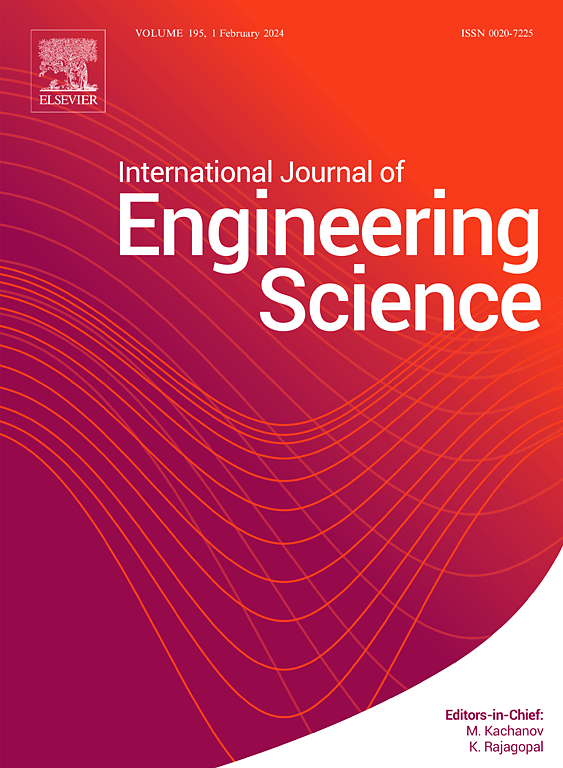Physics augmented machine learning discovery of composition-dependent constitutive laws for 3D printed digital materials
IF 5.7
1区 工程技术
Q1 ENGINEERING, MULTIDISCIPLINARY
International Journal of Engineering Science
Pub Date : 2025-09-19
DOI:10.1016/j.ijengsci.2025.104381
引用次数: 0
Abstract
Multi-material 3D printing, particularly through polymer jetting, enables the fabrication of digital materials by mixing distinct photopolymers at the micron scale within a single build to create a composite with tunable mechanical properties. This work presents an integrated experimental and computational investigation into the composition-dependent mechanical behavior of 3D printed digital materials. We experimentally characterize five formulations, combining soft and rigid UV-cured polymers under uniaxial tension and torsion across three strain and twist rates. The results reveal nonlinear and rate-dependent responses that strongly depend on composition. To model this behavior, we develop a physics-augmented neural network (PANN) that combines a partially input convex neural network (pICNN) for learning the composition-dependent hyperelastic strain energy function with a quasi-linear viscoelastic (QLV) formulation for time-dependent response. The pICNN ensures convexity with respect to strain invariants while allowing non-convex dependence on composition. To enhance interpretability, we apply sparsification. For the time-dependent response, we introduce a multilayer perceptron (MLP) to predict viscoelastic relaxation parameters from composition. The proposed model accurately captures the nonlinear, rate-dependent behavior of 3D printed digital materials in both uniaxial tension and torsion, achieving high predictive accuracy for interpolated material compositions. This approach provides a scalable framework for automated, composition-aware constitutive model discovery for multi-material 3D printing.
物理增强机器学习发现3D打印数字材料的成分依赖本构定律
多材料3D打印,特别是通过聚合物喷射,可以通过在单个构建中以微米尺度混合不同的光聚合物来制造数字材料,从而创建具有可调机械性能的复合材料。这项工作提出了一个综合的实验和计算调查的成分依赖的机械行为的3D打印数字材料。我们通过实验表征了五种配方,将柔软和刚性的uv固化聚合物结合在单轴拉伸和扭转下,跨越三种应变和扭转率。结果显示非线性和速率相关的响应,强烈依赖于组成。为了模拟这种行为,我们开发了一个物理增强神经网络(PANN),该网络结合了用于学习成分依赖的超弹性应变能函数的部分输入凸神经网络(pICNN)和用于时间依赖响应的准线性粘弹性(QLV)公式。pICNN保证了相对于应变不变量的凸性,同时允许对组合的非凸依赖。为了提高可解释性,我们采用L0稀疏化。对于随时间变化的响应,我们引入了多层感知器(MLP)来从组成中预测粘弹性松弛参数。所提出的模型准确地捕获了3D打印数字材料在单轴张力和扭转下的非线性、速率依赖行为,对内插材料成分实现了很高的预测精度。这种方法为多材料3D打印的自动化、成分感知本构模型发现提供了一个可扩展的框架。
本文章由计算机程序翻译,如有差异,请以英文原文为准。
求助全文
约1分钟内获得全文
求助全文
来源期刊

International Journal of Engineering Science
工程技术-工程:综合
CiteScore
11.80
自引率
16.70%
发文量
86
审稿时长
45 days
期刊介绍:
The International Journal of Engineering Science is not limited to a specific aspect of science and engineering but is instead devoted to a wide range of subfields in the engineering sciences. While it encourages a broad spectrum of contribution in the engineering sciences, its core interest lies in issues concerning material modeling and response. Articles of interdisciplinary nature are particularly welcome.
The primary goal of the new editors is to maintain high quality of publications. There will be a commitment to expediting the time taken for the publication of the papers. The articles that are sent for reviews will have names of the authors deleted with a view towards enhancing the objectivity and fairness of the review process.
Articles that are devoted to the purely mathematical aspects without a discussion of the physical implications of the results or the consideration of specific examples are discouraged. Articles concerning material science should not be limited merely to a description and recording of observations but should contain theoretical or quantitative discussion of the results.
 求助内容:
求助内容: 应助结果提醒方式:
应助结果提醒方式:


